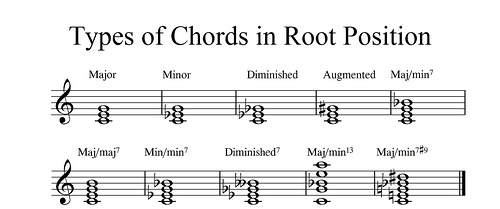Chord (Music)
 From Conservapedia
From Conservapedia A chord in music consists of multiple notes played simultaneously, though two notes played simultaneously are usually called an interval. The notes used to "build" a chord are usually assigned numbers, starting with "1" to denote the "root" note, which provides the name of the chord. Flat (♭) and sharp (♯) symbols are used to alter the position in the key that given notes are drawn from. In Western music, chords are usually based upon the interval of the third, whether major or minor. Impressionist composers including Claude Debussy and jazz musicians such as Bill Evans have often used chords built on stacked fourths.
There are many types of chords in Western music, including (examples all have C as the root):

- Major chord - consists of three notes with an interval of a major third followed by a minor third: 1-3-5, C-E-G
- Minor chord - the third is dropped one half step: 1-♭3-5, C-E♭-G
- Power chord or open fifth - the third is dropped (common in hard rock): 1-5, C-G
- Seventh chord - adds a fourth note, which depends on the key or sound desired.
- Major seventh chord: 1-3-5-7, C-E-G-B
- Major-minor seventh chord: 1-3-5-♭7, C-E-G-B♭
- Minor seventh chord: 1-♭3-5-♭7, C-E♭-G-B♭
- Half-diminished seventh chord: 1-♭3-♭5-♭7, C-E♭-G♭-B♭
- Fully-diminished seventh chord: 1-♭3-♭5-♭♭7, C-E♭-G♭-B♭♭
- Augmented chord - at its simplest, the fifth is raised a half step: 1-3-♯5, C-E-G♯
- Diminished chord - the third and fifth are both dropped one half step: 1-♭3-♭5, C-E♭-G♭
- Ninth chord - at its simplest, adds a fifth note, usually contains a flatted 7: 1-3-5-♭7-9, C-E-G-B♭-D
- Eleventh chord - usually adds only the interval of the eleventh over a Major-minor seventh chord: 1-3-5-♭7-11, C-E-G-B♭-F
- Thirteenth chord - usually adds only the interval of the thirteenth over a Major-minor seventh chord: 1-3-5-♭7-13, C-E-G-B♭-A
At this point, chords can start to have incredibly complex structures, for instance, the ninth chord described above could be minor, augmented, diminished, have a flat or sharp ninth, omit the fifth, etc. The eleventh chord often uses a sharp 11th and/or a minor third, a very characteristic sound in jazz. The thirteenth chord is often heard in Romantic music, and in such cases is heard as a 6-5 suspension.
The use of different kinds of chords (and chord progressions) is very important to the sound and feel of different styles and genres of music.
Categories: [Musical Terms]
↧ Download as ZWI file | Last modified: 02/17/2023 08:03:07 | 37 views
☰ Source: https://www.conservapedia.com/Chord_(music) | License: CC BY-SA 3.0
 ZWI signed:
ZWI signed: KSF
KSF